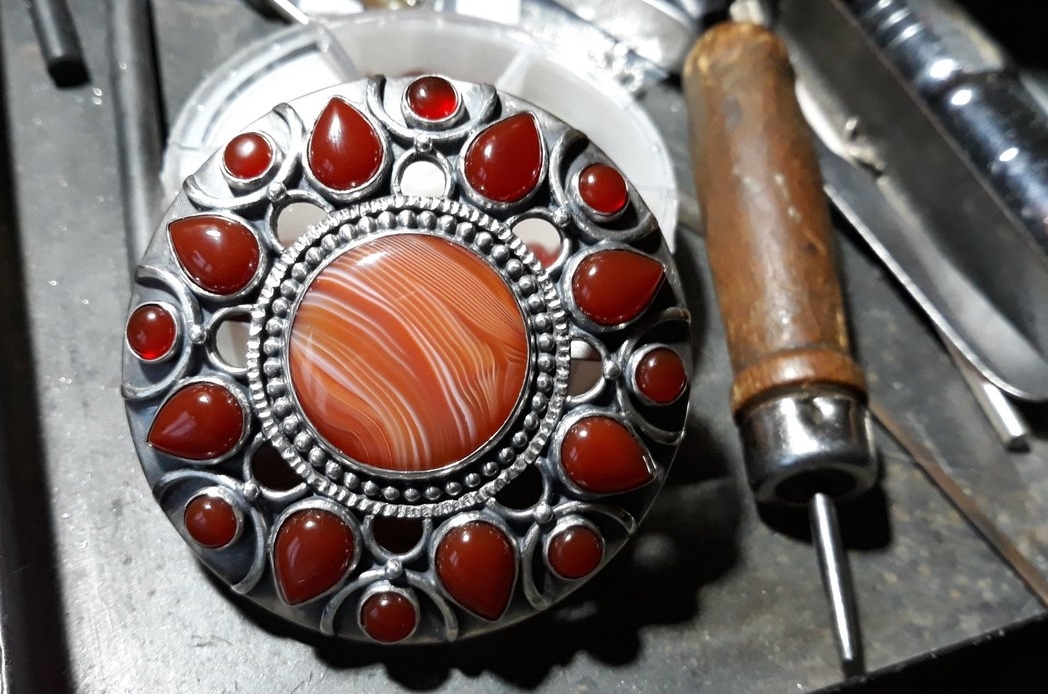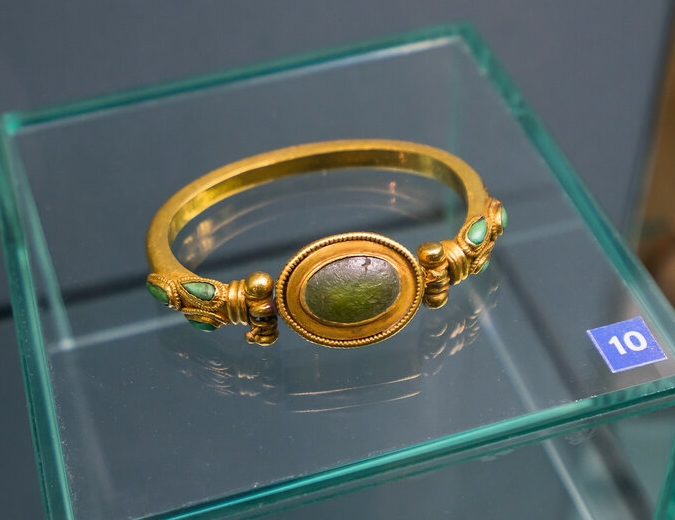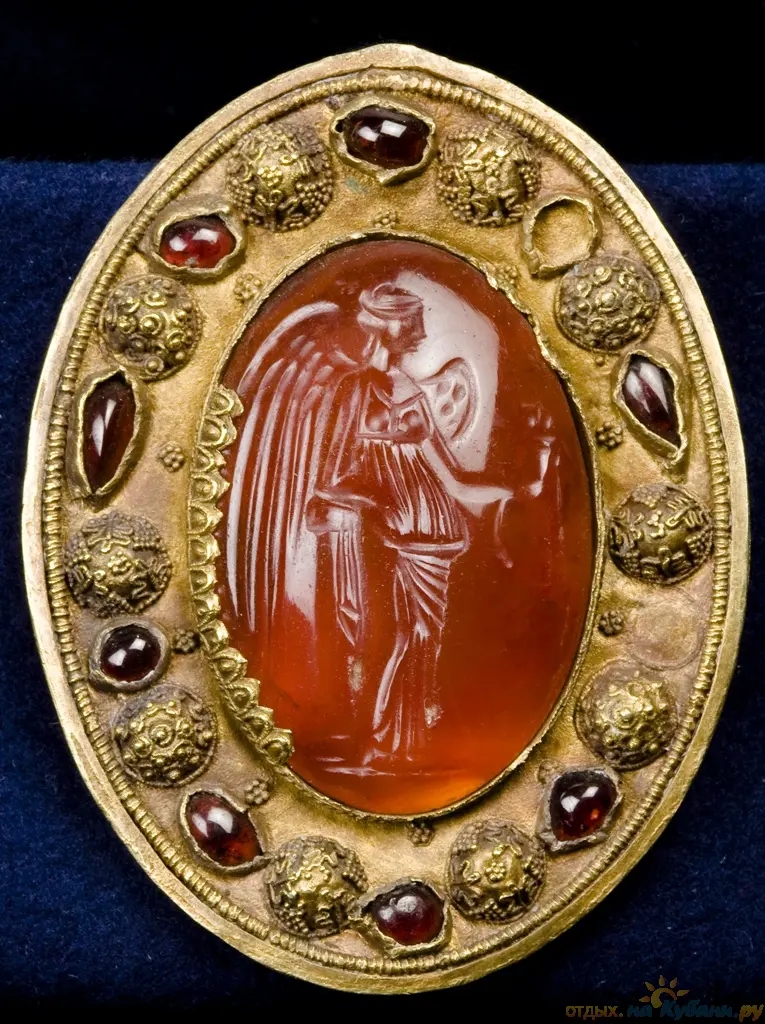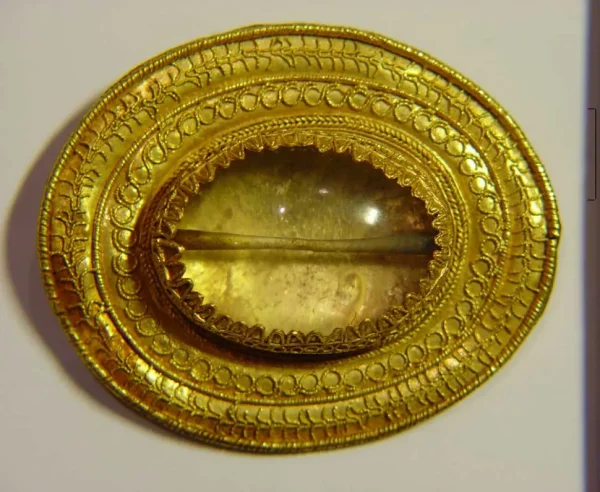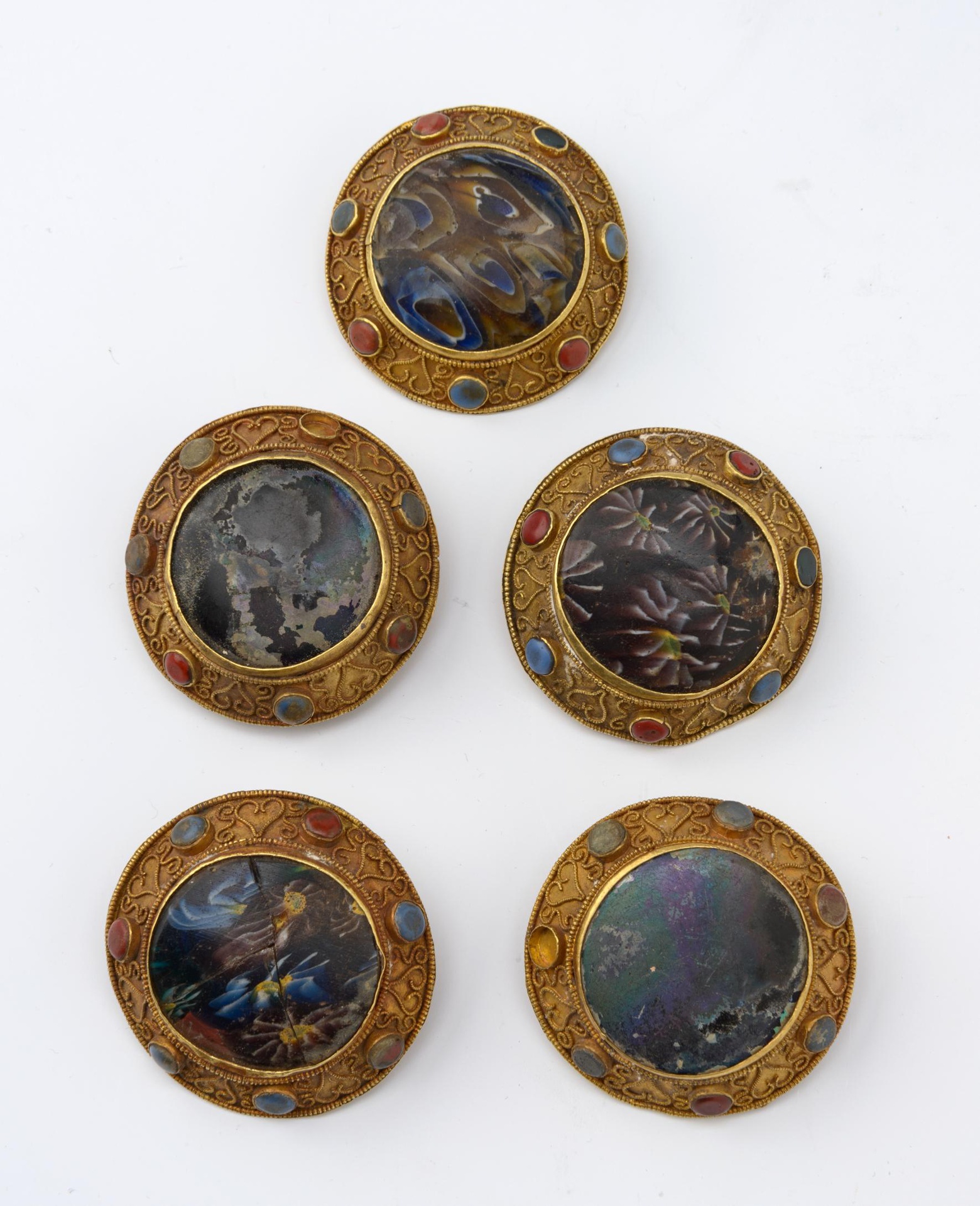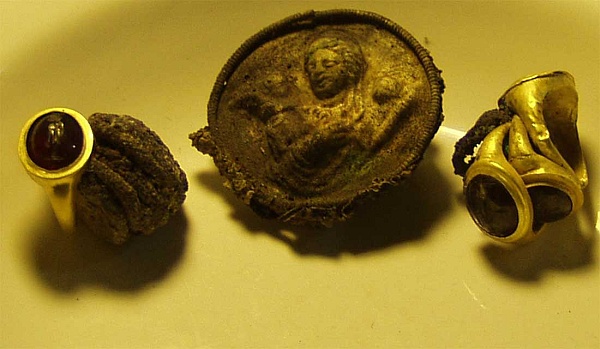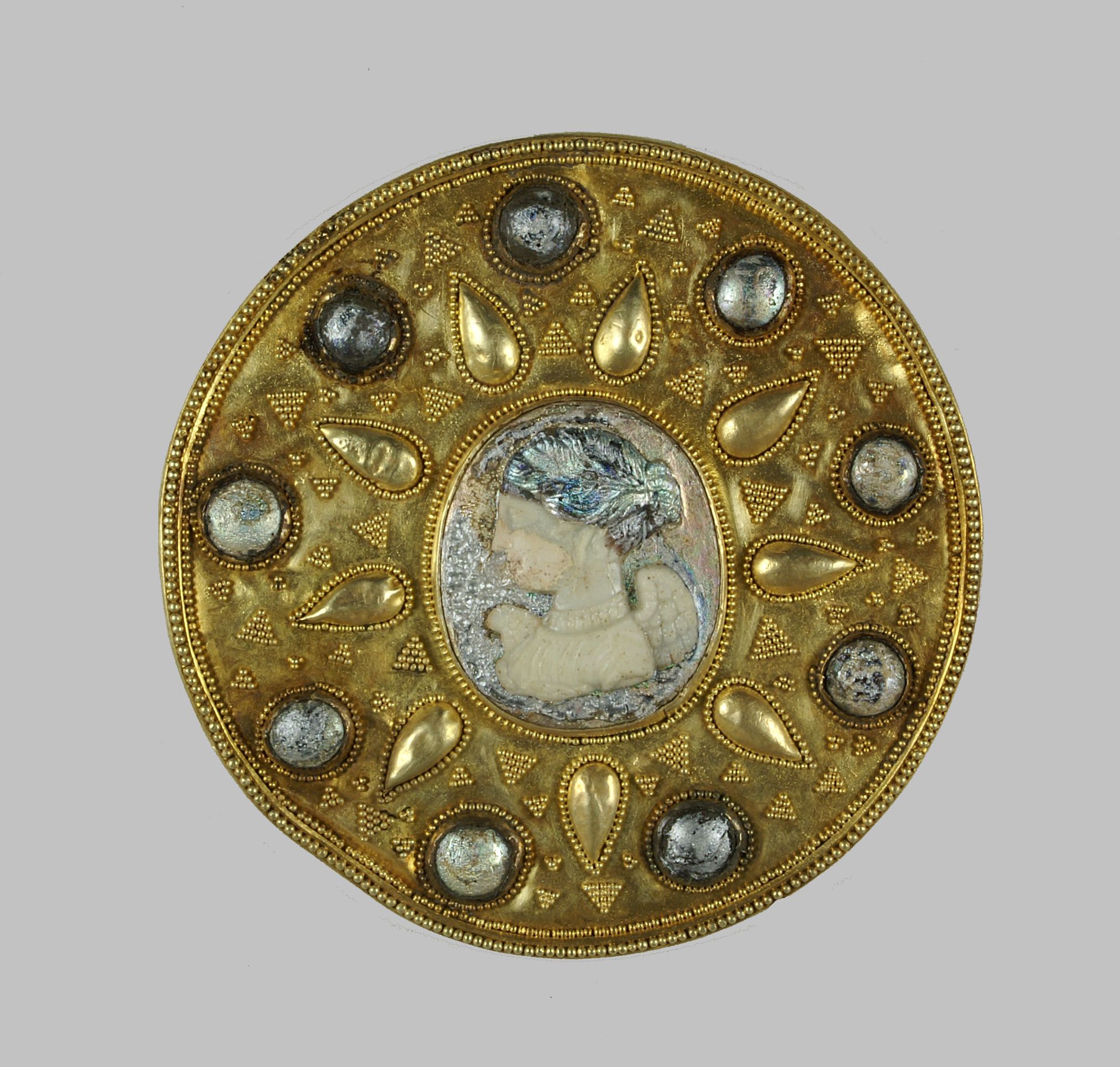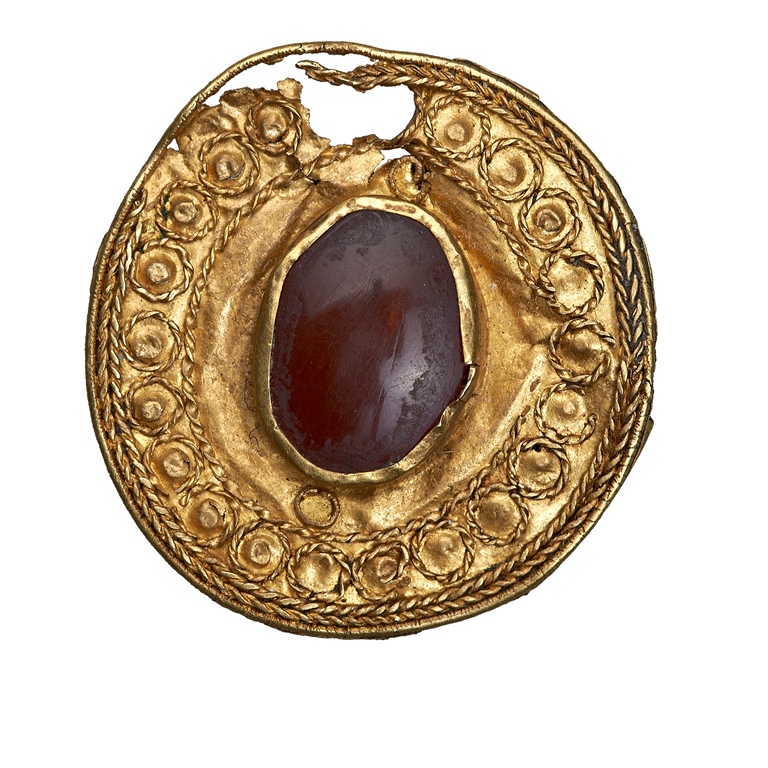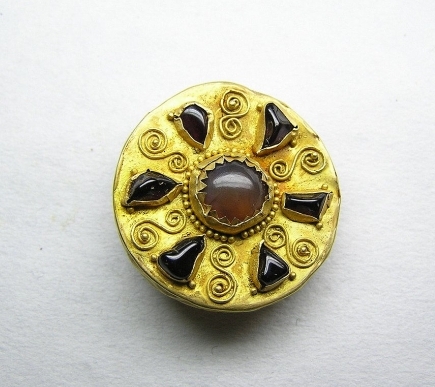Jewelry sold on auctions by TimeLine Auctions Ltd. London, UK

Sold Feb 23, 2021, auction description [link]
Dated to the 2nd-1st C BCE, 11.99 grams, 50mm, probably Kuban area.
The brooch was examined by prof. M. Treister.
“2nd-1st century BC. A sheet-gold brooch with cells; the shield an ellipsoid plaque with band of braided gold filigree surrounding a large central applied cell with filigree and ropework collar, inset chalcedony gemstone; at each narrow end two gold teardrop cells containing orange glass cabochons flanking a median cell shaped like an ivy leaf with the sidewalls of the cells scrolled outwards to form smaller round cells with cabochon inserts; reinforcing plates to the reverse and pierced lug suspension loop.
Formerly in the M. Velensky collection, London, UK, 1990s; accompanied by a copy of a five page examination report number 113/2019 by Dr. hab. Mikhail Treister; and an independent specialist report and valuation by graduate gemmologist and jewellery expert Anna Rogers, GIA GG, BA, Gem-A, ref. no.168728/07/12/2020; this lot has been checked against the Interpol Database of stolen works of art and is accompanied by AIAD certificate number no.10349-168728.
Dr. Treister writes ‘The brooch discussed belongs to the type, characteristic for the nomadic burials primarily of the Kuban area … of the 2nd-1st centuries BC / 1st century AD. … In course of ancient refurbishment two groups of inlays were added to the brooch. … Most probably refurbishment of the brooch took place some time in the second half of the 1st century BC or even in the early 1st century AD.'”
“2nd-1st century BC. A gold ellipsoid brooch with inset central gemstone; the shield with concentric bands of beaded filigree enclosing a band of triangular granule clusters and granule collar to the central cell; applied pin-loop and carrier to the reverse, scrolled catch to the rim opposite; central garnet cabochon with intaglio standing figure of Tyche (Roman Fortuna) wearing a floor-length robe and modius headdress, cornucopia in one hand and rudder in the other.
Formerly in the M. Velensky collection, London, UK, 1990s; accompanied by a copy of a five page examination report number 65/2008 by Dr. habil Mikhail Treister dated 8 December 2008, and an expertise from Striptwist Ltd, a London-based company run by historical precious metal specialist Dr Jack Ogden, reference number 180228/04; an independent specialist report and valuation by graduate gemmologist and jewellery expert Anna Rogers, GIA GG, BA, Gem-A, ref. no.168727/07/12/2020; this lot has been checked against the Interpol Database of stolen works of art and is accompanied by AIAD certificate number no. 10350-168727.
Dr. Treister remarks ‘stylistically the intaglio inserted in the brooch discussed is undoubtedly of Hellenistic Eastern Mediterranean origin and should be dated to 2nd – early 1st centuries BC…..the late Hellenistic gem was inserted in a somewhat later object. … The brooch could have been most probably manufactures [sic] in the late 1st century BC – 1st century AD and decorated with an earlier intaglio of probably Alexandrine or Levantine origin, dating to the 2nd or early 1st century BC.'”

Eastern Mediterranean origin, dated to 2nd – early 1st centuries BCE. Garnet intaglio with an image of Tyche
9.24 grams, 33mm
[link]


Sarmatian gold brooch with carnelian, garnet and red and green glass paste. 61 grams, 59mm (2 1/4″). Dated to the 1st C BCE – 1st C CE by prof. Treister.
“1st century BC-1st century AD. A substantial gold disc brooch with applied pin-ring and catch to the reverse for a double pin; the face with applied beaded wire ring enclosing triangular clusters of granulation and tubular cells with glass cabochon inserts (mainly red and two green) and one pear-shaped cell with garnet insert; central filigree ring enclosing a beaded wire border to the centre cell with inset carnelian gemstone. For brooch type see the Morgan Museum, New York, ref. 2012.2:14.21.
Formerly in the M. Velensky collection, London, UK, 1990s; accompanied by a copy of a five page examination report number 64/2008 by Dr. hab. Mikhail Treister dated 8 December 2008; an independent specialist report and valuation by graduate gemmologist and jewellery expert Anna Rogers, GIA GG, BA, Gem-A, ref. no.168726/07/12/2020; this lot has been checked against the Interpol Database of stolen works of art and is accompanied by AIAD certificate number no. 10351-168726. Dr. Treister writes: ‘This brooch … belongs to a rare group of late brooches which are known from… the Kuban area and maybe dated to the late 1st century BC – 1st century AD…This rare brooch with its rich variety of filigree, granulation and garnet inlays in a good state of preservation… is one of the finest known examples of the Kuban style in jewellery.'” [link]
2nd-1st century BC. 38.61 grams total, 11cm
” A substantial gold disc brooch with chains and pendants; the shield comprising a sheet-gold panel with applied granules to the rim and beaded filigree guilloche, beaded gold wire collar enclosing a band of omega-shaped filigree appliqué, triangular granulated clusters with domed bosses and four piriform cells set with garnet cabochons, central garnet or imitation in a setting with granulated claws; to the lower rim, seventeen loops each with a gold wire ending in a sphere and lunate finial with beaded wire border, looped ends with inset granules. Formerly in the M. Velensky collection, London, UK, 1990s; accompanied by a copy of a seven page examination report number 66/2008 by Dr. habil Mikhail Treister dated 8 December 2008, and an expertise from Striptwist Ltd, a London-based company run by historical precious metal specialist Dr Jack Ogden, reference number 180221/FD; an independent specialist report and valuation by graduate gemmologist and jewellery expert Anna Rogers, GIA GG, BA, Gem-A, ref. no. 8724/07/12/2020; this lot has been checked against the Interpol Database of stolen works of art and is accompanied by AIAD certificate number no. 10433-168724. Dr. Treister writes: ‘This rare brooch with its rich variety of filigree, granulation and garnet inlays in a good state of preservation ….is one of the finest known examples of the Kuban style in jewellery.'”

39.36 grams, 13 cm
https://www.liveauctioneers.com/en-gb/item/96954228_large-sarmatian-gold-pin-brooch-with-pendants
“2nd-1st century BC. A substantial gold disc brooch with chains and pendants; the brooch a sheet-gold disc with beaded gold wire rim surrounding three bosses with granulated ornament and three bosses with granules each set within a beaded filigree hoop; tapering pin to the reverse; interstitial applied filigree ornament of granules and beaded filigree scrolls; beaded filigree ring surrounding triangular granule clusters, central boss with similar clusters to the lower body and granulation above; eight applied loops to the lower rim of the brooch, from each a trichinopoly chain supporting a lobed plaque with applied filigree and granules, two loops to the lower edge and from each loop a short chain with sheet-gold disc finial; mounted in a custom-made display box. Dr. Adams, N. edn., Masterpieces of Eurasian Art, London, 2008. Formerly with Pierre Bergé & Associés, Paris, Archéologie, 30 May, 2015, lot 177 (16,000 / 18,000 euros); previously in an English collection; accompanied by a ten page examination report by Dr. habil Mikhail Treister dated 14 December 2007; an independent specialist report and valuation by graduate gemmologist and jewellery expert Anna Rogers, GIA GG, BA, Gem-A, ref. no.168725/07/12/2020; copies of the relevant pages from Masterpieces of Ancient Eurasian Art where this piece is published; and a copy of the relevant Pierre Bergé & Associés catalogue pages; this lot has been checked against the Interpol Database of stolen works of art and is accompanied by AIAD certificate number no. 10352-168725.”
